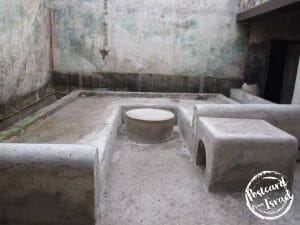It was the mid-1980s and my archaeologist-husband and I were invited to visit the excavations at Sepphoris (Zippori) by some co-workers of his from Hebrew University. (I know, I know, I wasn’t even born yet, but let’s just imagine…!) In those nascent days of the dig, “the Mona Lisa of the Galilee” mosaic (1987) had not been uncovered, nor had the 6th-century synagogue’s mosaic floor full of zodiac depictions (1993) which turned up when the parking lot was under construction. But everyone knew that this would become a major site, having been beautified under Antipas, Herod’s son, after his father’s death in 4 BC, then becoming the seat of the Jewish Sanhedrin in the 3rd century before it moved to Tiberias.
The small town of Nazareth was about 3 miles away. Jesus grew up in the shadow of Zippori, which later became a huge Roman administrative capital of the Galilee, with a theater and soldiers, but in the days of Yeshua’s childhood, it was still very much a Jewish city….
With pagan symbols and Roman building styles for those of wealthy and even priestly families. Hmmm….
But no pig bones.
It was Jewish. With more than a nod or two to popular culture. That was the world into which Jesus came.
Times haven’t changed much.
But back to the table! (Focus, MB….) It’s the table we’re examining today. Yes, a mosaic floor was uncovered at Sepphoris, in the shape of a T. (Not that the English alphabet existed, right?) The T-shaped mosaic fit nicely into a U-shaped table, the Triclinium table of Roman times.
Diners (generally men, let’s call it like it was) would be seated around the outside of the often-stone or marble low-lying table. Could have been wood, but then we would not be finding that thousands of years later in archaeology…. Servants would come into the U and serve from the inside, not having to disturb diners from behind. Pillows or cushions would prop up the diners’ left arms, upon which they leaned, close to the table, while eating only with their right hands. Feet would be tucked behind them, most of their weight again on the left leg.
 This photo of a Triclinium set-up from Pompeii is a variation on a theme.
This photo of a Triclinium set-up from Pompeii is a variation on a theme.
They did not sit criss-cross-legged style. They did not sit upright.
Sorry, Leonardo DaVinci, Jesus was not seated in the middle of one, long, straight table for the Last Supper. Observing the U-shape from above with an ancient drone (!), Jesus would be seated at the upper right-hand side, the second seat in from the end. This was the seat of honor.
We understand that John, the disciple who was quite close to Jesus, leaned backward toward Jesus’ chest and asked him a confidential question: who will betray you? So John was reclining on the end, or the top-right of the U.
The one who would dip in the same communal bowl as Jesus would be Judas, most likely seated in the third place from the end, right next to the person he would betray. Peter, who should be washing the feet of the disciples, was located at the complete opposite end of the U, the upper-left-hand side. It would be easy to communicate with him across the open expanse and draw to his attention to the fact that no one’s feet had been washed, a common custom of hospitality. The feet became quite dirty whether in sandals, or in bare feet, on dusty roads, so they were stretched out, or tucked behind and usually washed by the host or his servant.
It would be like offering someone a place to wash their hands at home, or a wet-wipe out on a dig! Soothing.
A bottle of water.
A glass of iced tea at a table with an umbrella.
Can you imagine the Lord waiting for you in such a welcoming atmosphere?
“Come and dine. I’ve spread the table. Let’s have a talk together. Enemies, shmenemies, you’re in my presence, safe and secure.”
Recline and dine.





Comments are closed.